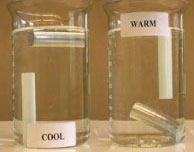 |
NASA | GSFC | JPL | Site Map |
|
|
 |
 |
Education: Student Outcomes |
Click here to search for other assets Reversing Rods Grade level: 9-12 Theme: water cycle Activity: http://www.tos.org/hands-on/teaching_phys_concepts.pdf
Thermal expansion is the principle by which a liquid thermometer works. In the ocean, thermal expansion is thought to contribute significantly to sea level rise on decadal-to-century-long time scales. However, thermal effects appear to be influenced by decadal climate-related fluctuations, making it difficult to estimate the long-term contribution of thermal expansion to sea level rise. Current estimates suggest that thermal expansion is responsible for 25 percent to 50 perccent of observed sea level rise. In this activity, we look at thermal expansion using two rods, one made of aluminum and the other made of PVC. When placed in cold water, both rods initially float because their densities are lower than that of the cold water. Over time, the PVC rod gets colder and contracts, which results in a density change. When the density of the rod exceeds that of the water, the PVC sinks. The aluminum rod gets colder too, but aluminum expands and contracts much less than PVC when its temperature is changed by the same amount; therefore, the aluminum rod's density is less affected by the temperature change, and it remains floating. Students will also try this experiment with hot water. Videos
Flash Video | QuickTime MovieStudent Outcomes After completing this activity, students should be able to: Explain the influence of the El Niño Southern Oscillation on global weather patterns. (O: 9-12) Key: C = climate / O = ocean circulation / T = 21st century technology / W = water cycle |
|||||
